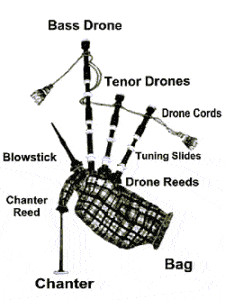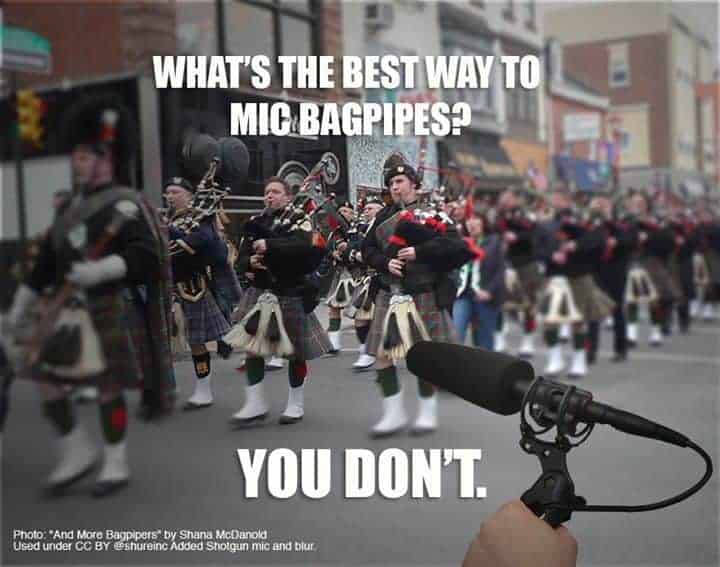New Bands are experimenting with Classical instruments like Violin, Americana instruments like Mandolin, and Roots instruments like Bagpipes. Stretching and experimenting to bring something new. Bag Pipes are part of that. But how can a powerful instrument like Bagpipes be miked for Recording Studios or Home Studios? Best Microphone and Placement for Recording Bagpipes
- Use 1 Standard mic with a pad-20dB 1-3 ft. from Piper
- 1 Ribbon or Stereo Mic close to Chanter the other Behind the Piper 18″-24″ from Drones.
- Or, off the Piper, 1-3 ft away to capture the Chanter (in front of the piper) 1 for the Drones behind a piper, Make sure that the phase of the mics is aligned.
I remember the first time I listen to Copperhead Road by Steve Earle and heard the sound of Bagpipes as a lead instrument in the song. It brought an incredible presence to the song. I don’t think it could have been as powerful with any other instrument.
How To Record Bagpipes
Bagpipes are considered a woodwind instrument. The instrument creates its characteristic sound by vibrating enclosed reeds from a constant source of air from the bag. One or more drone pipes create the characteristic drone tone(s) or the bagpipes while a chanter pipe is used to play the melody.
The bagpipes are limited by their range of nine diatonic notes and are often played as a solo instrument or accompanied only by percussion instruments that you might see in a parade. No doubt once you hear a Bagpipe it’s a unique sound. You will always recognize it when you hear it again.
They are loud and dramatic and especially difficult to record. Mostly Bagpipes will are played outside and volume is not a problem but in many certain situations, Miking is essential for live shows at big venues and recording circumstances, and which mic and the placement needed is key to how successful it sounds even in a small space for Home Recording Studios like yours.
The idea of adding a track filled with a Bagpipe for someone like me who has been recording a while is awesome. In the world of Bagpipes recording, they are essential for practice. It is considered as valuable a tool as the quality of the instrument itself. In able to progress in playing the Bag Pipes it is important to listen to yourself. New sounds in music are adding
For Practice, a quality Digital Recorder is a popular way of recording Bagpipes, because of its high-quality built-in features such as surround sound and mid-side mic range for greater coverage. The new recorder comes with more power and longer battery life.
Zoom is known for handheld digital recording the best and highest quality sound. Like this one called Zoom H4N PRO Digital Multitrack RecorderEasy to handle and get to the controls and perfect for Bagpipers to operate while performing. Some Bagpipers are very satisfied with the sound of a Shure SM 57 with one microphone just off in the general direction of the player.
Royer Ribbon Mic
Others highly suggest a Royer Ribbon microphone. The Mic is can be impressive in how it is able to mix the Pipes with other instruments. Just give it a little space maybe 1 to 3 feet from the source and it captures things very beautifully.
Ribbon mics tend to calm the harsh tones so place one fairly close to the chanter and the other behind the piper about 18″ – 24″ from the drones. This mic placement will give a reasonable degree of separate control over the two elements. This is also done with some experimentation and according to the room and how filled the room may be. These types of mics with this placement are arguably the best.
The specs of the microphone are critical so make sure they are there before settling on a microphone. 
- Overall Range: 415 Hz ~ 15,000 Hz
- Fundamentals range: 415 Hz – 932 Hz (A♭4-B♭5)
- Harmonics range: 830 Hz ~ 15,000 Hz
- Flat Frequency Response: Choosing a mic with a flat frequency response that will reproduce the sound of the bagpipes accurately without excess coloration.
- Gentle High-Frequency Roll-Off: Although you want a flat frequency response, the bagpipes often yield a harsh sound. Pick a mic with a gentle roll-off in its high-frequency response will lighten the piercing high frequencies and yield a smoother reproduction of the bagpipe sound.
- Directionality: Select a microphone with a polar pattern that works with the miking technique you use on bagpipes.
Brand of Ribbon Mic:
Royer R-121: This is a popular ribbon microphone and flagship product from Royer Labs. This microphone reproduces the sound of bagpipes with great accuracy and reduces the potential harshness of the instrument. Harshness is the biggest problem or at least the biggest complaint from capturing a set of Bagpipes. Whether you are tasked with making the bagpipes in mono (with one mic) or in stereo (with a pair of mics), Royer Labs R-121 Large-Element Ribbon Microphone
AEA R88: The next mic that is suited for the work is a stereo microphone with two ribbon diaphragms. This microphone is a top stereo mic recommendation for bagpipes. Because the bagpipes are often played alone, it’s beneficial to capture a stereo image of the instrument. The R88 provides excellent sonic capture and a consistent stereo image when recording the bagpipes.
Proper Microphone Placement
Because of the problem of bouncing echoes in a bigger room, you do need to get the microphones close to the pipes, and you need a pad such as 20dB on the mic body if you can. Sound people would set up the mics in front of the piper, not behind, as the chanter is a slightly more interesting bit. There is no real “Best Way” only some miking techniques that have worked in the past.
According to a few forums, the best ones are independent of others and experimenting is needed. One forum member who was a long-time player said” that what’s needed is three elevation levels of microphones, one set at chanter level, one set at about neck level, and one set above the drones in order to catch all of the harmonics.
What a piper perceives is what is called “being on the inside” they hear the mixed tones of the drones and the harmonics because they are in the middle of the sound (maybe a microphone on top of the headphones?) the piper also feels the tone through the bag and the chanter “communicates” with the drones through the bag, in essence, the piper feels the pipes as well as hearing them if the piper has done his tuning right the audience won’t know it but they’ll feel it. Recording Engineers were kind of blown away by this.
More Pipers agree that a simple way to record a Bagpipe is to record using something like a Ribbon hand-held or on a tabletop stand with a shock-mount about a foot from the end of his chanter and to monitor with headphones and set the levels carefully.
Handheld Recorders are back in the conversation. An Outside recording is preferred over an inside recording because even though there are too many variables when playing outside, Bagpipes are meant to be played Outside.
Another Technique for miking bagpipes is to use two relatively close mics between one a three feet to capture the chanter (in front of the piper) with the sound of the drone (behind the piper). Making sure that the phase of the mics is aligned is important here. Other Techniques are:
- Use 1 Standard mic with a pad-20dB 1-3 ft. from Piper
- 1 Ribbon or Stereo Mic close to Chanter the other Behind the Piper 18″-24″ from Drones.
- Or, off the Piper, 1-3 ft away to capture the Chanter (in front of the piper) 1 for the Drones behind a piper, Make sure that the phase of the mics is aligned.
The Bagpipes are ancient specialty instruments that are not recorded very much and are played more in outside events that can’t be synthesized or imitated. They are the real deal and when they are played they tend to stop us in our tracks for a moment and just listen.
JimGalloway Author/Editor

Mikingdesign


